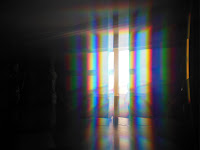A
ceremonial mace is a decorated staff, used to represent a leader's authority
and prestige. That leader could be a
monarch, military commander, or civil servant.
The design of the mace is based on the original mace, an ancient blunt
weapon with a heavy head to deliver powerful and fatal blows. In their early history, a ceremonial mace was
also a practical weapon, used by a Sergeant-at-Arms to defend the leader it
represented. Today, that is no longer
the case.
In
Canada, every provincial and territorial legislature has a ceremonial mace
representing its power and authority.
Nunavut's Legislative Assembly received its mace on April 1, 1999, when
the territory officially came into existence.
The mace is crafted from narwhal tusk; the animals on it represent the
connection between land, sea, and food.
The crown is made from Nanisivik silver and carved to show four common
loons coming together. The loons come
together over a large blue lapis lazuli ball that was taken from Kimmirut. The cross on top of the crown represents the
British Crown. At the tip of the mace is
a 2 ¼ carat diamond from the Jericho Diamond Mine. The mace was collectively made by six Inuit
artists: Inuk Charlie (Cambridge Bay), Paul Malliki (Repulse Bay), Simata
Pitsiulak (Kimmirut), Mathew Nunqingaq (Iqaluit), Mariano Aupilardjuk (Rankin
Inlet), and Joseph Suqslaq (Gjoa Haven).
When
Members of the Legislative Assembly (MLAs) meet in Iqaluit, the
Sergeant-at-Arms carries the mace over their right shoulder, leading a
procession of Pages, Clerks, and the Speaker.
While the MLAs debate, "the mace rests in the hands of a man and
woman carved in granite and labradorite."
There
actually exist two Nunavut maces: the original and a replica. While the original remains in Iqaluit, the replica
'visits' northern communities with the aid of the Sergeant-at-Arms and an
MLA. On April 10, the replica and MLA Hunter Tootoo came to Arctic Bay. Hunter Tootoo
has represented the Iqaluit Centre constituency since 1999. He has also held many ministerial positions
such as, Minister of Education, Nunavut Housing Corporation, and
Homelessness. In May of 2011, he was
elected to serve as Speaker of the Legislative Assembly.
Teachers
& students of Inuujaq School filed into the gym after lunch for the
presentation of the mace. Also in
attendance were the town's mayor, Frank May, and MLA Ron Elliott. A large colourful banner with the greeting
"Welcome to Arctic Bay" hung at one end of the gym. Just in front of it were a line of tables
where the mace would be displayed. After
the mace was brought in by Hunter Tootoo, the assembly began with introductions
in English and Inuktitut, followed by a prayer.
Iga Muckpa's Inuktitut class had prepared a welcome display featuring
throat singing, drum dancing, and the singing of a traditional Inuit song. It was a great display of Inuit culture.
The
assembly continued with Hunter Tootoo introducing himself and the mace. He gave a brief autobiography then continued
with a more detailed biography of the mace.
He spoke in English and Iga translated in Inuktitut. At the end of the presentation, he took
questions from the audience. From my
observations, his answer to the first question, posed by an elementary student,
stunned everyone. In English, the student asked if he could speak Inuktitut? He replied that he couldn't. A short but awkward pause followed.
Students
& teachers lined up to view the mace after the Q&A session. No one was allowed to pick it up. They were all excited to see a piece of
Nunavut history. When it was my turn, I
took as many pictures as possible because I had afternoon recess duty. I ran out of time before I could get a
picture of myself standing behind it.
Thankfully, there is always another time. I found the craftsmanship of the replica mace
to be very impressive. I think this was
the third Canadian ceremonial mace I saw up close. The first two were the maces of the House of Commons and the Senate at Parliament Hill in Ottawa.
Several
days after the assembly, Iga's Inuit Culture class posted two large, hand-drawn
posters of the mace in the high school area. The posters were in English & Inuktitut,
explaining the parts of the mace and the artists who crafted it.


















































